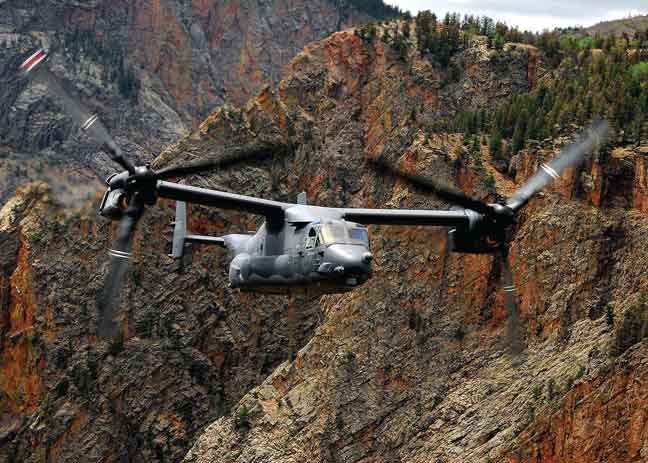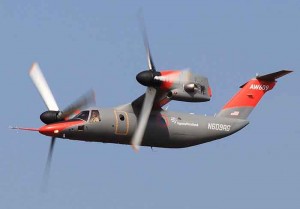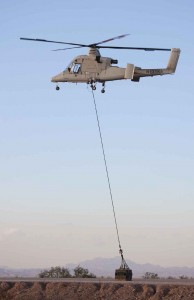There are many other safety related problems that beset a helicopter design; some of them are loss of tail rotor effectiveness, ground resonance, mast bumping, loss of control during negative ‘g’ conditions, power settling, dynamic roll-over, anti-torque rotor failures, the requirement for unusually quick response in case of engine failure and the non-feasibility of an ejection system for the crew. Thus, over the last few years, it was realised that there was a need to move away from the original shape but retain the Vertical Take Off and Landing (VTOL) characteristic of a helicopter. Developing a practical, hybrid aircraft with the performance of a fixed wing aircraft in forward flight has proven to be a surprisingly difficult task.
Bell Helicopter has been dominant in tilt-rotor development with major designs from almost every decade back to the 1950s…
The engineering challenge consisted of achieving two main goals. The first was to accomplish controllable vertical flight using the very same mechanisms and equipment that are required for forward flight. Any weight of exclusively vertical flight mechanisms would be useless during forward flight and would represent a reduction in available payload relative to a comparable fixed wing aircraft capability. The second goal consisted of achieving ‘power matching’ i.e. a VTOL design that requires the same power in vertical flight as in forward flight. Any mismatch would represent excess capacity which corresponds to excess weight in one mode of flight. Numerous approaches to VTOL aircraft have been explored over the years; the prominent ones are tilt-rotors, tilt-props and tilt-wings, as well as deflected-slipstreams, deflected-thrust, thrust augmenters, ducted fans, tilt ducted rotors and tail sitters.
As the name implies, a tilt-rotor aircraft uses tiltable (rotating) propellers, or proprotors, for lift and propulsion. For vertical flight, the proprotors are angled to direct their thrust downwards, providing lift. In this mode of operation the aircraft is essentially identical to a helicopter. As it gains speed, the proprotors are slowly tilted forward, eventually becoming perpendicular to the ground. In this mode the wing provides the lift, and the wing’s greater efficiency helps the tilt-rotor achieve its high speed. In this mode, the platform is essentially a turboprop aircraft.
Bell Helicopter has been dominant in tilt-rotor development with major designs from almost every decade back to the 1950s. They are currently partnered with Boeing on the first production tilt-rotor aircraft, the jointly developed and manufactured Bell/Boeing V22 Osprey. Tilt-rotor proprotors require all the fundamental parts of a twin-rotor helicopter. They also have a full set of airplane controls and a tilt mechanism that rotates the lifting rotors while carrying flight loads. This means that the cost of a tilt rotor is typically 50 to 100 per cent more than a helicopter of the same power and empty weight.
The Bell V-280 Valor is a tilt-rotor concept being developed by Bell Helicopter and Lockheed Martin for the US Army…
Incidentally, India’s Aviation Research Centre (ARC), responsible for electronic surveillance and signals intelligence along the country’s borders with Pakistan and China, wants to acquire Bell-Boeing V22 Osprey tilt-rotor aircraft to augment its operational capabilities. According to IHS Jane’s, Bell-Boeing has recently provided ARC with price estimates and delivery schedules for four Ospreys to be acquired via the US Foreign Military Sales route. The ARC Ospreys could be used to deploy Special Frontier Force personnel and provide them logistic support on missions in tandem with Research and Analysis Wing (RAW), India’s external intelligence-gathering agency.
The Chinese toy industry has popularised the quadcopter globally. However, aircraft designers in pursuit of VTOL technology have found that the quadcopter does not perform impressively when scaled up to a size with significant payload. Bell and Boeing are working on larger Quad Tilt Rotor (QTR) military models for possible use by the US Army. The QTR has two sets of fixed wings and four tilting rotors mounted at the tips of the wings. The program has been nicknamed the V44 Tilt Rotor for the four tilt rotor version and V66 Tilt Rotor for the six tilt-rotor version. These poly-tilt-rotor aircraft have also been called “The Flying Freight Train” for their large capacity almost the size of a railcar which could carry as many as 100 passengers or troops or heavy cargo over 50,000 pounds. They would use advanced versions of the tilt-rotor engines used for the V-22 Osprey.
The UK-based aerospace company AgustaWestland is developing AW609 formerly known as Bell/Agusta BA609, for civilian use. In an allied development endeavour called Project Zero, AgustaWestland is working on the world’s first electric tilt-rotor aircraft, as a technology demonstrator termed Project Zero. Each of its two rotors is driven by its own electric motor, which is powered by rechargeable batteries. The aircraft’s control systems, flight controls and landing gear actuators are also all electrically powered, so there is no need of the hydraulic system. Besides, the aircraft doesn’t require a transmission as well. A first flight was demonstrated in early 2013, but a dateline for production is yet to be announced. A hybrid version, which would use a diesel engine to power a generator, is under consideration.
The K-MAX is a UAS transformed by Lockheed Martin Corporation and Kaman Aerospace Corporation…
NASA’s Greased Lightning or GL-10 deserves a mention here. It is a battery-powered, ten-engine remotely piloted tilt-rotor and the prototype has a ten feet wing span and can take off vertically like a helicopter as also fly efficiently in forward flight. It is in design and testing phase and flew a series of test flights during early May 2015. The final version is expected to have a 20-foot wing span.
The Bell V-280 Valor is a tilt-rotor concept being developed by Bell Helicopter and Lockheed Martin for the US Army. In one major difference from the earlier V22 Osprey tilt-rotor, the engines remain in place while the rotors and drive shafts tilt. A driveshaft runs through the straight wing, allowing both proprotors to be driven by a single engine in the event of engine loss.
Besides tilt rotors, VTOL aircraft could have other designs like ducted fans Bell X22A, Ryan XV5A/B, hovering platforms UrbanAero X-Hawk, or the Elytron design which combines three sets of wings and one pair of rotary wings called ‘proprotors’, mounted on a single tilt-wing in central position and two pairs of fixed wings or the Disc Rotor in which for hover, a set of blades are extended from the periphery of the disc, much like a helicopter but forward flight is like a fixed wing aircraft with the blades either fully retracted into the disc or with two of the rotors sticking out like conventional lift producing wings.
Unmanned Craft
While toy helicopters, especially quadcopters, are easy to construct, practical drone helicopters with useful payload become increasingly complex to design. The maximum and most interesting variations of helicopter designs are emerging in the Unmanned Aircraft System (UAS) regime. The GL10 mentioned earlier is a small tilt-rotor but there is a spectacularly successful drone helicopter that has pioneered its way to fame.
The K-MAX is a UAS transformed by Lockheed Martin Corporation and Kaman Aerospace Corporation from an existing helicopter model of Kaman to enable US Marines to deliver supplies by day or night to precise locations without risking lives. The aircraft can fly at higher altitudes with a larger payload than any other rotary wing UAS. It can lift and deliver 2,700 kg of cargo at sea level and over 1,800 kg at 15,000 feet density altitude. With its four hook carousel, the K-MAX UAS can also deliver more cargo to more locations in one flight in autonomous or remotely controlled operations. The K-MAX did laudable service in Afghanistan and has proven the concept beyond any reasonable doubt. The future can be expected to see more variations of the concept in optionally manned versions as well.
The Mars Helicopter would revolutionise the manner in which future Mars exploration could progress…
Another noteworthy helicopter innovation is the Mars Helicopter being developed by NASA. A team at NASA’s Jet Propulsion Laboratory is working on a prototype, autonomous, solar powered helicopter that would work as a scout for a rover, giving NASA teams a heads-up to what they might encounter ahead and steering them toward the best possible location. Due to the large distance from Mars, remote control is not technically feasible in real-time as it would take minutes for radio waves to travel one way between Mars and any control station on Earth. Therefore, the Mars Helicopter would be totally autonomous. The Mars Helicopter would revolutionise the manner in which future Mars exploration could progress and is expected to be ready well in time for the Mars 2020 Rover.
US Future Vertical Lift Programme
It is not possible to describe all the developments going on in vertical lift technology across the world but it is worth mentioning the Future Vertical Lift (FVL) programme of the US Department of Defence (DoD) because of the focussed approach it adopts towards the problem of new types of rotorcraft for US Army beyond 2030. In October 2011, DoD issued the FVL Strategic Plan to outline a joint approach for the next generation vertical lift aircraft for all military services.
The FVL concept is to create new rotorcraft using new technology, materials and designs that are quicker, have further range, better payload, are more reliable, easier to maintain and operate, have lower operating costs and can reduce logistical footprints. FVL is to create a family of systems to replace most Army helicopters. A precursor for FVL is the Joint Multi-Role (JMR) helicopter programme, which will provide technology demonstrations planned for 2017. JMR Phase I will develop the air vehicle while JMR Phase II will develop mission systems.
The FVL concept is to create new rotorcraft using new technology, materials and designs…
The US Army plans to acquire as many as 4,000 aircraft from the FVL programme as a replacement for its UH-60 Black Hawk, AH-64 Apache, CH-47 Chinook and OH-58 Kiowa helicopters. The main contenders are Bell Helicopter, Boeing/ Sikorsky (jointly), AVX Aircraft, EADS North America, Piasecki and Karem Aircraft. In tandem, the US Army’s Improved Turbine Engine Program (ITEP) is aimed at a 2023 production goal. Advanced Turbine Engine Company (ATEC), a 50-50 joint venture of Pratt & Whitney and Honeywell, is competing with GE Aviation to develop a drop-in replacement for the legacy GE T700 engines that power the Boeing AH64 Apache and Sikorsky UH60 Black Hawk fleets. The engine is also expected to power light rotary-winged aircraft expected to emerge from the FVL programme.
Conclusion
Technological advances have brought impressive improvements in rotorcraft technology albeit without eliminating the intrinsic limitations. The classic helicopter design has been mutated into newer types of rotorcraft or hybrid VTOL ones. Nonetheless, the majority of helicopters retain the original tadpole-like shape with a main rotor and a tail rotor. Designers all over the world are persistently and continually seeking breakthroughs to achieve incremental performance parameters. Advances in high technology regimes continue to provide slow but steady support.
Upgrades cost a fraction of the cost of a newer helicopter although the upgraded version may not turn into a new helicopter in terms of performance…
For the helicopter operator, technological progression holds out two different but related promises. The first concerns new and innovative changes to rotorcraft design and is predicated to new projects and enterprises. We have seen glimpses of such novel inventions in the foregoing narrative.
However, there is another way in which technological advances are becoming expedient for the helicopter industry and that is the increasing capability to upgrade existing models so as to increase their performance, role capability and utilisation for new missions. Not only that, upgrades can also prolong the life of a particular model and render it safer for example, by reduction in vibration levels.
Needless to say, upgrades cost a fraction of the cost of a newer helicopter although the upgraded version may not turn into a new helicopter in terms of performance. It would appear that, at least for a decade more, upgrades of existing, tried-and-tested models are likely to be at least as prominent as the emergence of new machines.







